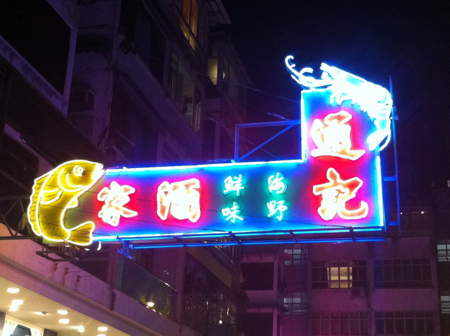[dropcap character=”C”]rayVox is a project completed for the IASKA Space(D) Biennale on exhibition at the Fremantle Arts Centre February to March 2012. The exhibition is now on a Australia wide tour.
For most of the Autumn of 2011 I was living in Cray fishing communities on the Houtman Abrohlos Islands which are situated some 60 ~ 100 km west of Geraldton in Western Australia. The Abrohlos are the southernmost coral islands in the world and are home to a unique fishing industry which is struggling with issues of commercial enterprise within the context of environmental stewardship at a time of environmental and climatic change. I also followed the catch researching the live crayfish trade as the critters are exported to Asia, visiting fish markets, auctions, and the kitchens and dining rooms in SW Asia.
First up some short videos.
CrayVox, Nigel chats with Sam Liddon. from Nigel Helyer on Vimeo.
Nigel chats with cray fisherman and surfing Maestro Sam Liddon from Post Office Island in the Southern Group. Sam’s Island was the first port of call for the CrayVox project.
And a short contextual talk.
The CrayVox project was accompanied by an Artists book in the form of an Altas/Cookbook in Chinese and English. Here is a sample page from the CrayVox Book – please use the contact form to purchase a copy.
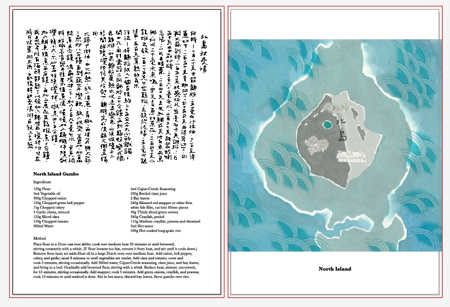
The text which follows is extracted from the introduction.
This is the old Hessle Road
The home of Bear Island Cod
Where the Husdsons speak only to the Helyers
And the Helyers speak only to God
[dropcap character=”M”]any years ago I found this verse, found pinned to a bulkhead of a trawler in Hull on the cold North Sea. The saying Salt is in the Blood speaks not only of my family history but to our collective origins ~ our blood has the same salinity as sea water, a reminder of our evolutionary prehistory and a caution that we share our fate with our aqueous mother, who controls our climate and our atmosphere.
The CrayVox project has allowed me to reconnect with memories from early childhood, growing up in a small Sussex fishing village, the fisherfolk using open wooden boats and tarred wicker Lobster pots. The Lobsters of course were destined (then as now) for the wealthier members of the community, but we fared well by collecting small sweet Mussels, Periwinkles and Sea lettuce in rock pools with Sea kale garnered from the shingle banks.
The dazzling bleached coral islands and brightly coloured shacks of the Houtman Abrolhos Islands, which became my home for several months during 2011, were simultaneously otherworldly but strangely familiar.
I had come with an open mind but also with many questions concerning the ecology and economy of Cray fishing, curious about this isolated community and idiosyncratic lifestyle; my job in this situation I decided was to look and learn ~ but also to discuss and debate the future viability and sustainability of our marine ecologies and marine economies with my hardworking and generous host families.
The Abrolhos fishery is promoted as the worlds first environmentally sustainable fishery and is heavily monitored and controlled by the department of fisheries (1). This however has driven considerable changes in both the fishing techniques, vessel size and economic risk, not to mention the fact that the catch is almost exclusively for export and therefore disconnected from the local food cycle ~ operating as a resource extraction industry not dissimilar to iron ore mining!
My task has been to develop a suitable metaphor to support and communicate the broad raft of concepts; images and information that accumulated during my sojourn on the Islands. The form of the Cray boat was chosen as a vessel to contain an audio-portrait of both the islands and my subsequent travels to SE Asia, following the export trail to seafood importers, restaurants and cooks. The skeletal vessel in the exhibition itself becoming a resonant object projecting the energy and complexity of the Abrolhos and its people.
Note (1)
The Abrolhos Islands are protected as an A Class Nature Reserve ~ it is interesting to reflect that only 4% of Australian waters are protected as marine parks and reserves and globally only 0.36% of the oceans (which account for 70% of the planets surface area) are afforded protection.
Images of the Space(D) Biennale exhibition at the Fremantle Arts Centre 2012 and of course in such circumstances, what could be better than a fisheye lens!
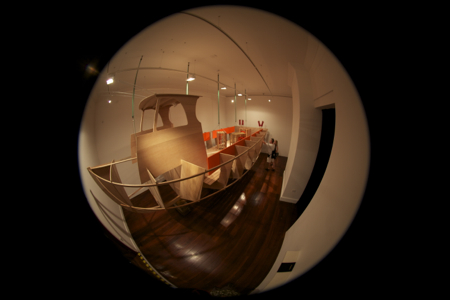
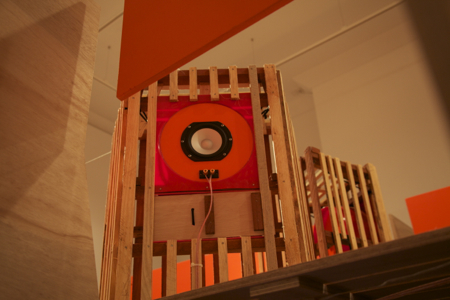 CrayVox is an x8 channel soundsculpture that employs three Craypot speakers
CrayVox is an x8 channel soundsculpture that employs three Craypot speakers
a public address horn and four solid-drive audio actuators, see the orange side panels.
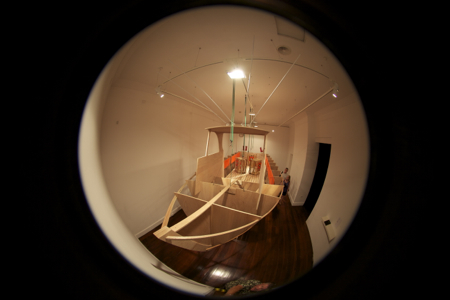
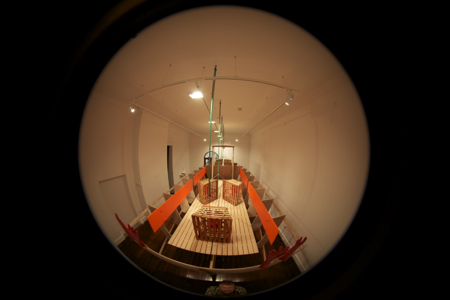
Solid drive actuator panels forming the boundary of the deck area.
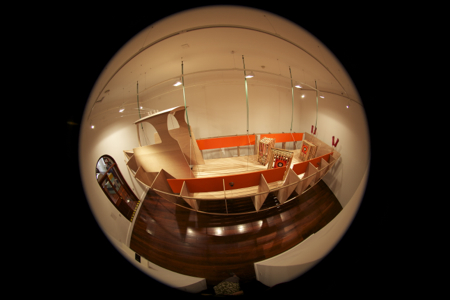
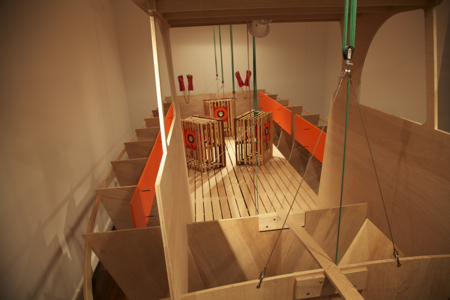
The Space(D) Art out of place Biennale is on tour for a couple of years and I have re-worked the project into a Micro and a Mini version, here are some images of the Mini CrayVox_V3 installed at the Geraldton City Gallery February ~ March 2013.
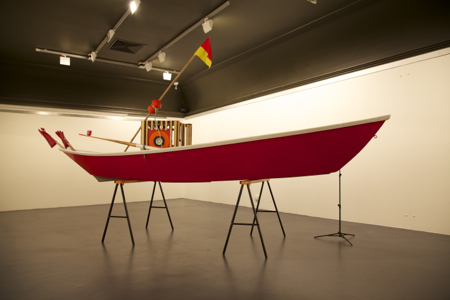
CrayVox_V3 is a four channel sound sculpture driven by mobile audio actuators, the content is extracted from the larger eight channel original.


And here are some extracts from my diary kept whilst on the Islands
and during my research in SE Asia.
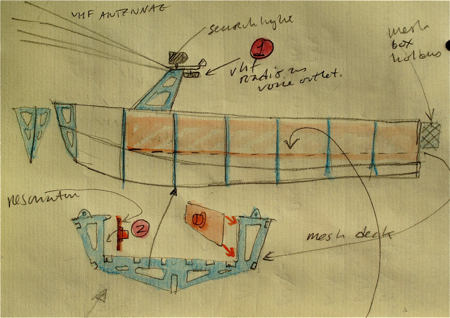
[dropcap character=”A”]toll.
The Island, a cemetery exhaled by the sea.
The tree of life, calcinated to a bleached white clinker raft.
Whilst all around, submerged beneath the endless sheet of water
Fronds branch and entwine, filament and fan, knoll and star
Electric pink jostles acid green, fading to sombre blue where the sharks sleep
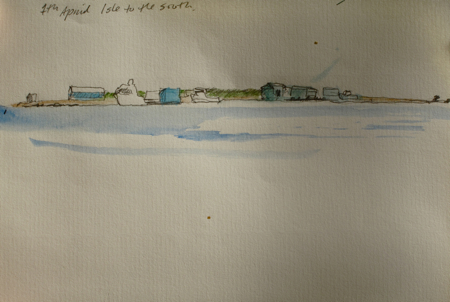
[dropcap character=”S”]tone.
A stone shown as a curio for there are no stones on this island, only coral, loose brittle and resonant, bearing the imprint of life that thrives in the waters hard by the strand.
Skimming over acres of it en route to nearby Basilli Island, named for a family of Italian fishermen, or perhaps they are named for the Island, with lives and livelihoods so entwined with place it is hard to tell.
In the cul de sac of a cement path named Cathedral Street stands a miniature catholic church, furnished with a neat array of small wooden school chairs, a series of ceramic tiles which illustrate the stations of the cross and two Madonnas, one a faded, framed print on the Altar, the other a plaster statuette balancing on a corner shelf; both gaze at wilted candles, a testament to passion past.
Basili is all neatness, it’s shacks painted in electric rainbow colours, the floats and ropes ordered as if by the compulsions of a Mediterranean matriarch with little else to do in a sleepy coastal village.
The rock, likewise a transposition, arriving as ballast on a sailing vessel, which either floundered here or jettisoned this lode in lieu of a cargo, lies alongside a whale vertebrae and pearl nacre, a conduit to other worlds.

[dropcap character=”P”]ost Office Island.
Today clouds, a light breeze and another very high tide. The crew are out cleaning the Pearl Lines with the small boat and a high pressure water jet. I commandeer the runabout and drift about the islands trolling with a hydrophone for underwater soundscapes (mostly snapping shrimp and the occasional grunter) and takes some images of the coral heads that almost scrape the hull of the boat.
Later in the afternoon we all pile aboard the bigger jet-boat and head North to Big Rat Island to pick up a visitor at the airstrip. We are making 20 knots with our 370 horsepower diesel powered jet, somewhat like a seaplane on the verge of lift-off, we simply lack wings. It’s a fast, rough and very wet ride and I make a discovery, cold beer really does settle the stomach!
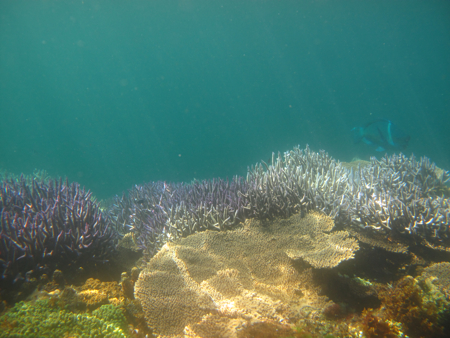
[dropcap character=”E”]l Halcedor.
In that Empire, the Art of Cartography reached such a Perfection, that the map of one single Province covered a whole Town. With time, these excessive Maps ceased to give satisfaction, and the Colleges of Cartography drew up a Map of the Empire which was done to the same scale as the Empire itself, and which coincided with it at every point. Less absorbed in the study of Cartography, the following generations came to conclude that this vast Map was useless and not without Impiety, abandoned it to the inclemencies of the Sun and Winters. In the deserts of the West, there survive shattered Ruins of the Map, inhabited by Beasts and by Beggars; in all the Land, no other relic of the Cartographic Disciplines remains. Jorge Luis Borges.
[dropcap character=”2″]up
It has been a week of constant movement, travelling from one Island to the next, on and off boats and light planes; tramping over different terrains. I am beginning to get a feel for the patterns, the biology and the various social networks ~ starting to grasp the complexity of the Cray industry, not simply the almost Baroque ecology of the of the Crayfish itself but also the labyrinthine attempts to regulate and maintain a sustainable fishery.
On Little Rat I sleep in a small cabin at the end of the wharf which rocks and moans in the high winds, I fret that I will be swept away! On West Wallabi I encounter a minefield of Mutton Bird burrows (the favourite food of Sea Eagles) and spend half my trek falling over into thorny bushes. We attend the ANZAC dawn service and then join in the 2up which attracts boats from all the other islands ~ free beer and burning sunshine equals sore heads! On North Island I discover a village like atmosphere full of friends and family, small kids catching gigantic fish on the pontoons.
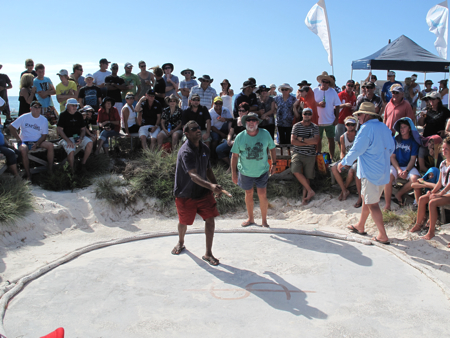
[dropcap character=”Q”]ui Gung, the Cray position.
I looked across to the outer Islands and studied the breakers heaving themselves onto the coral ridges of the seaward side; I listened to the wind hissing through the structures on the jetty and I drew in the odour of diesel fuel mixed with Cray-bait. Downing two sea-sickness tablets I hauled my gear onboard the laden Crayboat and tried to keep out of the way as the skipper and deckle manoeuvred the crates into position and hooked up the water hoses to irrigate the live catch. The skipper descended for the flying bridge as soon as we were through the shoals and slammed the throttle full forward sending us hurtling into a two metre seaway. For the next three hours I hung in a Qui Gung like pose behind the wheelhouse, knees bent to absorb the pounding, hands firmly gripping the rail and eyes fixed alternatively on the horizon and the ETA readout on the GPS map which gradually counted down to the shore, to solidity and dryness.
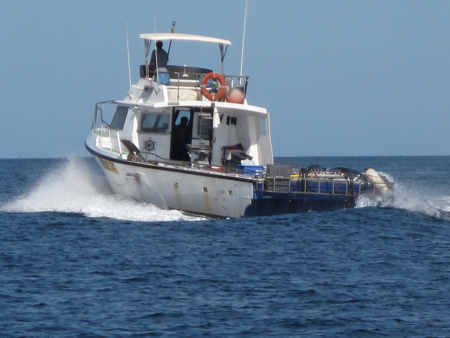
[dropcap character=”E”]xoskeleton.
The more I see of them and observe their behaviour, the more they remind me of cockroaches – an ever present thought at supper time. Just what was that one thinking as the deckhand jokingly said “hey Nigel that one’s having a really good look at you.”
Hoisting itself out of the sorting bin and purposefully fixing me with its two protruding pearls of eyes, antennae and feelers symmetrically arranged to keep me at bay and moving a generous array of small underbody parts. What constitutes thought?
This creature is supposedly possessed of a ‘simple’ brain, a clot of neves lodged beneath the horned carapace that protects the eyes, surely it must be taxed just coordinating all these whirring body parts, all of those legs and feelers, unless of course they are mostly autonomous. So what constitutes thought?
Aliens, who needs aliens, our world is chocked with them, and doesn’t Geiger and Hollywood know it, being content to go no further than a simple mix and match; Crustacea and Insecta with a little help from Reptilia on occasion.
Of course from the perspective of numbers, of Biomass it is we who are the ‘fish out of water’ with our rather simplistic morphologies, our vulnerable soft tissue hung from frames of bone and lacking the useful ability to regenerate limbs. Perhaps the notion of intelligence has gone to our heads!
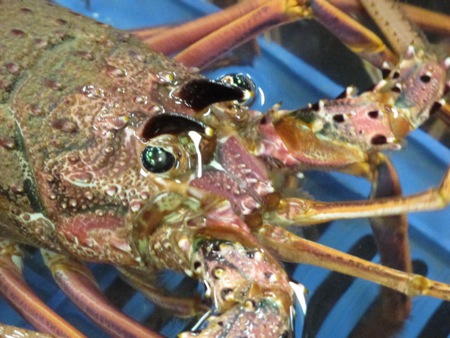
[dropcap character=”Y”]ou have to catch a Sprat to catch a Mackerel
The two small children cut pieces of Octopus tentacle and bait their hooks – within seconds another reef fish has impulsively impaled itself and the kids haul the parti-coloured victim onto the wharf where the line is disgorged and the creature is stilled with the point of a fillet knife.
A short ride across the main channel and we tie up at a small wharf that announces Coronation Atoll. Yet another coral rubble island with a scattering of mostly sealed up fisherman’s camps and a Pearl operation on the western point.
This atoll however is bisected by deep crevasses that suggest it is in the process of a slow disintegration as the sea percolates, invades and reclaims this semblance of terra firma. It is to one of these crevasses that we are bound, fish at the ready. We gaze down into a deep clear pool overhung by cantilevers of friable coral and there below cruise two enormous grey cod which have been imprisoned here for years. As soon as the children throw the first fish the pool churns as the cod rush to the surface, inhaling the offering whole – the waters still as the grey forms slide, attentive, like submarines from Holy Loch on red alert.
Clambering down into the crevice I wedge myself, semi-immersed in the pool, underwater camera thrust forward to get a clear view of the business end of the giant cod. As it approaches I begin to wonder how hungry it actually is, how fast it can move and how fast I can move but I guess it could always swallow the camera before tackling me!
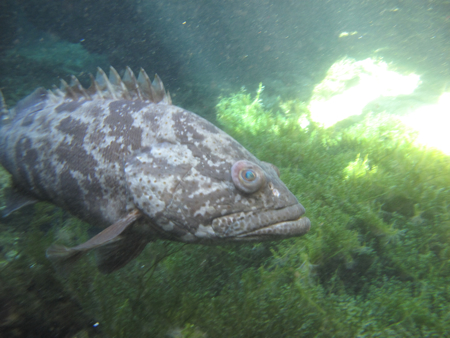
[dropcap character=”Y”]ellow Submarine
Back onshore for a few days R+R and R+D. Having a yarn with some of the ‘old-timers’ (yarning being their speciality) and looking at the ‘industrial’ end of the operation. The ‘Yellow Submarine’ was a prototype submersible launched in 1969 as a harvester equipped with mechanical arms to literally ‘pick-up’ Crayfish. It failed due to toxic gas build up ~ otherwise the Abrolhos would now look like a NATO navy base!
The holding tanks at the Geraldton Fishermans Coop are currently retaining 40,000 Kilos of live Crays, thats a big dinner party and an even bigger bill at the end of the evening!
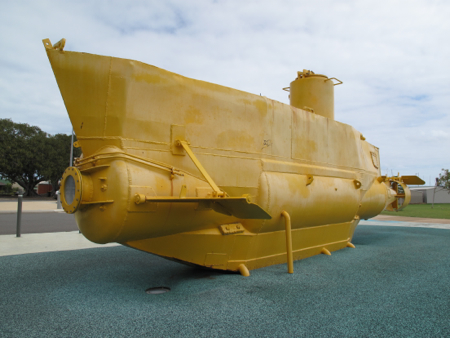
[dropcap character=”F”]ast food.
The cult of Taylorism has never touched this industry, no time and motion men have slid about on the heaving decks of a Cray boat, they would be superfluous, the job’s been done over decades of practice.
The skipper’s gaze flickers between the dots on the GPS screen and the waves ahead, fingers glancing the throttle and wheel. The vessel hauls up to the float, the grapple swings in and the line is passed to the deckhand who winds it onto the winch. The skipper flips the pot onto the tipper and halts the winch as the Crays tumble into the sorting bin. The skipper opens the two bait lids and slides the pot down the rail – the deckhand removes the remains of the bait, loads new bait and slides the pot down the rail to stack along with it’s coiled rope and float, ready to set.
All this takes a few seconds, a choreography practiced on a stage which dances and rolls with the swell, repeated over and over, day after day – time and tide wait for no man and time is money.
At each pull the Crays are sorted, size, gender, legs and feelers – the rejects flying overboard to thankfully dig their tails in hard and propel themselves to safety. All the while my interest has been steadily slipping from the routine on board to the three sinister forms that have been gliding beneath the hull for the past hours, following our every move, waiting for Crayfish to parachute in front of their snouts. This is my rationale for not swimming around here, sleek three metre Bronze Whalers with large grins and a taste for snack food!
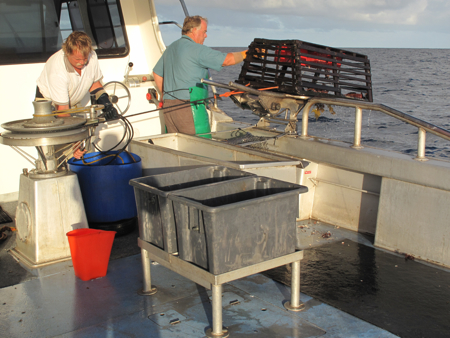
[dropcap character=”T”]he HydroLab.
My island circuit is completed by this return trip to the Southern Group and the shack on Post Office Island, after my meander northwards through the entire Houtman Abrolhos. Once again on familiar ground, this time accompanied by Artemis Kitsios, a colleague from the city who brings a HydroLab able to test the quality of the water; Oxygen, Salinity, Turbidity, Chlorophyll you name it!
We find that this new activity makes everyone a bit nervous as this is the type of research that the Fisheries Department like to pursue but I reassure all that we meet that our data will only be used to create soundscapes, a partly satisfactory and partly mystifying explanation. In short order I also struggle to explain Biennales, arts funding in general, and finish with a precis of Sound Sculpture.
We make a tour of the Island, noting the various environmental niches, the deep water wharves, the tidal sinkholes, the lagoon and the mangroves. The sensor probe is lowered at each site and as Artemis tackles the hideous interface of the data-logger I drop my hydrophone into the water and listen to the micro-chatter of tiny crustaceans and other coral dwellers who occasionally investigate the hydrophone by gently drumming a tattoo on it’s surface.
I stand motionless, entranced in the stellar static of shrimp clicks, the soft grunts and coughs of fish and the zipping of Crayfish antennae, oblivious to the shrieks of gulls that skim menacingly over my head.
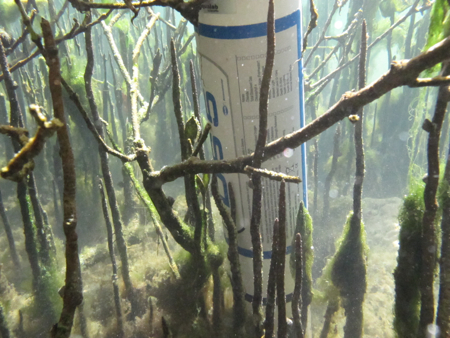
[dropcap character=”S”]nake Alley
A fine specimen gazing out from its glass tank, antennae sweeping through the stream of bubbles surging to the surface; unwitting traveler a world away from the reefy crevices of the Indian Ocean. Airlifted in a deep coma like some business class passenger, prostrate on an overnight long-haul. Revived to Crayfish consciousness in a cavernous Koahsiung seafood import warehouse; then by refrigerated truck to the back alleys of a Taipei night-market.
The feelers sweep again, no takers tonight, a reprieve from the boiling ocean of the cauldron. Next door a man downs a shot glass of snake venom mixed with blood as the chef grills the doomed reptile ~ I’m thinking that Tofu will suit me fine tonight!
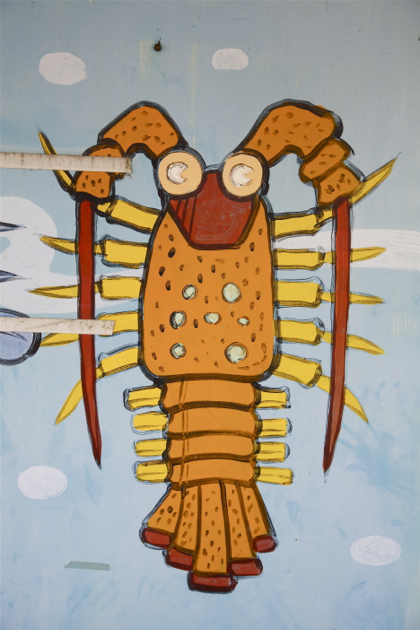
[dropcap character=”S”]treet stall
We are walking slowly along the coastal strip, a seaside park of giant crab sculptures and power boxes painted with cartoon fish. This isthmus wedged between an uninviting grey sand beach and a grimy container port supports a honky-tonk terrain of seafood joints and market stalls overflowing with dried cuttlefish, whitebait, sea cucumbers and other unidentifiable marine lifeforms.
The cook takes the initiative, throwing the two small crayfish onto the brass pan of the scales, $400 NT he declares. I counter his opening gambit by declaring they are too young to die ~ my translator doesn’t get it but we manage to escape. Juveniles I explain, keep catching those and there won’t be any left in three years. Ah, only caught by accident with other fish, she explains with authority ~ One has to be very purposeful to catch crayfish, I reply with a polite smile.
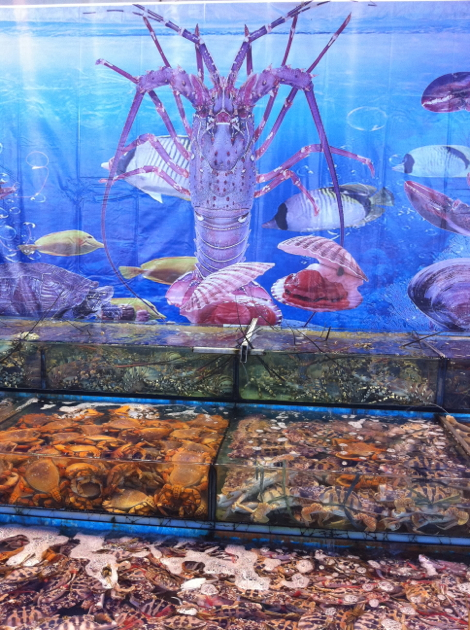
[dropcap character=”A”]uction
Everyone here has three things in common, gum boots, a wooden stick tipped with an iron hook and an electrical remote that sends dealer codes to the digital auction system ~ of course everyone also stinks of fish and has been up since the wee hours.
The auctioneers, wedged into their narrow catwalks, hemmed in by worn stainless steel rails push their little chariots with grimy laptops and damp papers to and fro as they move along the catch displayed below. On the left wrist an ink-pad used with alarming speed to stamp hardcopy transactions thrust toward them by the buyers at the close of each tirade of incomprehensible muttering.
Some have a minder, gesticulating wildly and grunting abruptly as an accompaniment to the rhythms of the auctioneer, a fishy courting ritual that flows and ebbs, pausing whilst the giant data screens reset to zero after each bid, only to escalate as the action resumes. The bidders mill and nod, all the while jostling one another to peer at the lots, hauling crates over the slippery floor with their metal-shod sticks. This shoal, this pod, this school of bidders flows around me, buffeting my recording equipment, the mike boom a surrogate fishing rod cast above a sea of heads.
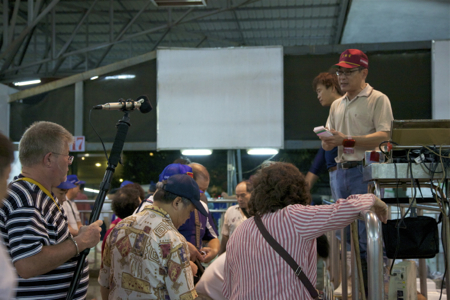
[dropcap character=”W”]asteful
Not to be taken lightly ~ food! He is Haka, weather beaten, close cropped hair, sparkling eyes. He leans towards the microphone perching on the edge of his seat, animated by the topic, savouring the memories of eating a crayfish banquet at his cousins wedding. He lick his lips, the best is Japanese style, no spices just fresh, sashimi and with the crayfish head displayed on the dish – this way he can worship his food.
He talks of catching Taiwanese crayfish on the rugged east coast, small but sweet – unlike those he ate in Sydney and Brisbane, huge portions one tail for each person and the flesh cooked with a sauce ~ yes tasty but so wasteful, it troubled him! In Taiwan everything is used, we are ashamed of waste, people here still remember being poor and hungry – we don’t waste anything at all.
